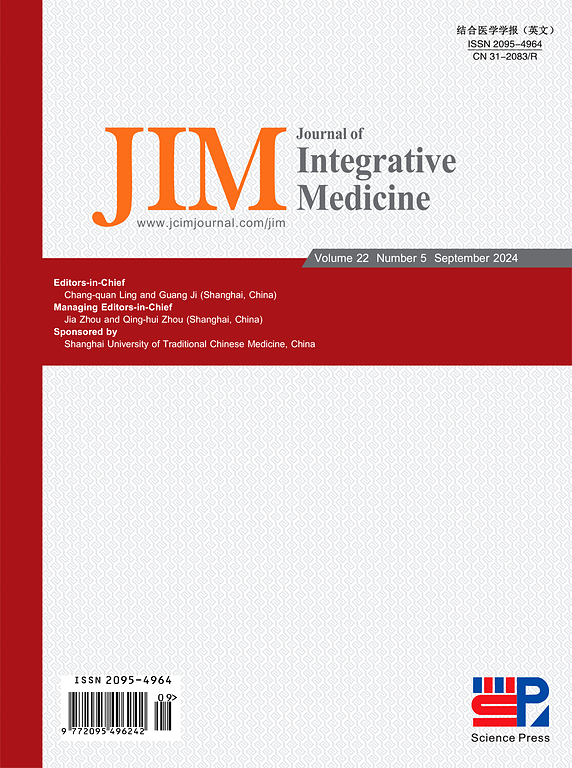Current situation of clinical trial registration in acupuncture anesthesia: A scoping review
IF 4
2区 医学
Q1 INTEGRATIVE & COMPLEMENTARY MEDICINE
引用次数: 0
Abstract
Background
Modern acupuncture anesthesia is a combination of Chinese and Western medicine that integrates the theories of acupuncture with anesthesia. However, some clinical studies of acupuncture anesthesia lack specific descriptions of randomization, allocation concealment, and blinding processes, with subsequent systematic reviews indicating a risk of bias.
Objective
Clinical trial registration is essential for the enhancement of the quality of clinical trials. This study aims to summarize the status of clinical trial registrations for acupuncture anesthesia listed on the World Health Organization International Clinical Trials Registry Platform (ICTRP).
Search strategy
We searched the ICTRP for clinical trials related to acupuncture anesthesia registered between January 1, 2001 and May 31, 2023. Additionally, related publications were retrieved from PubMed, Cochrane Library, Embase, China National Knowledge Infrastructure, China Science and Technology Journal Database, and Wanfang Data. Registrations and publications were analyzed for consistency in trial design characteristics.
Inclusion criteria
Clinical trials that utilized one of several acupuncture-related therapies in combination with pharmacological anesthesia during the perioperative period were eligible for this review.
Data extraction and analysis
Data extracted from articles included type of surgical procedure, perioperative symptoms, study methodology, type of intervention, trial recruitment information, and publication information related to clinical enrollment.
Results
A total of 166 trials related to acupuncture anesthesia from 21 countries were included in the analysis. The commonly reported symptoms in the included studies were postoperative nausea and vomiting (19.9%) and postoperative pain (13.3%). The concordance between the publications and the trial protocols in the clinical registry records was poor, with only 31.7% of the studies being fully compatible. Inconsistency rates were high for sample size (39.0%, 16/41), blinding (36.6%, 15/41), and secondary outcome indicators (24.4%, 10/41).
Conclusion
The volume of acupuncture anesthesia clinical trials registered in international trial registries over the last 20 years is low, with insufficient disclosure of results. Postoperative nausea and vomiting as well as postoperative pain, are the most investigated for acupuncture intervention.
Please cite this article as: Li Y, Liu YN, Guo Z, Gu ME, Wang WJ, Zhu Y, Zhuang XJ, Chen LM, Zhou J, Li J. Current situation of clinical trial registration in acupuncture anesthesia: A scoping review. J Integr Med. 2025; 23(3): 256–263.
针刺麻醉临床试验注册的现状:范围综述。
背景:现代针刺麻醉是将针刺理论与麻醉理论相结合的中西医结合。然而,一些针刺麻醉的临床研究缺乏对随机化、分配隐藏和盲法过程的具体描述,随后的系统评价表明存在偏倚风险。目的:临床试验注册对提高临床试验质量至关重要。本研究旨在总结世界卫生组织国际临床试验注册平台(ICTRP)上针灸麻醉临床试验注册的现状。检索策略:我们检索了ICTRP中2001年1月1日至2023年5月31日注册的与针灸麻醉相关的临床试验。检索PubMed、Cochrane图书馆、Embase、中国国家知识基础设施、中国科技期刊数据库和万方数据。对注册资料和出版物进行一致性分析。纳入标准:围手术期使用几种针灸相关疗法中的一种与药物麻醉相结合的临床试验符合本综述的要求。资料提取与分析:从文献中提取的资料包括手术类型、围手术期症状、研究方法、干预措施类型、试验招募信息以及与临床入组相关的出版物信息。结果:来自21个国家的166项与针刺麻醉相关的试验被纳入分析。纳入的研究中常见的症状是术后恶心和呕吐(19.9%)和术后疼痛(13.3%)。临床注册记录中出版物与试验方案之间的一致性很差,只有31.7%的研究完全兼容。样本量(39.0%,16/41)、盲法(36.6%,15/41)和次要结局指标(24.4%,10/41)的不一致率较高。结论:近20年来在国际试验注册中心注册的针灸麻醉临床试验数量较少,结果披露不足。术后恶心和呕吐以及术后疼痛是针刺干预研究最多的。本文编号:李勇,刘勇,郭忠,顾梅,王文杰,朱勇,庄晓军,陈立明,周军,李军。针刺麻醉临床试验注册现状:一项范围综述。集成医学[J];打印前Epub。
本文章由计算机程序翻译,如有差异,请以英文原文为准。
求助全文
约1分钟内获得全文
求助全文
来源期刊

Journal of Integrative Medicine-Jim
Medicine-Complementary and Alternative Medicine
CiteScore
9.20
自引率
4.20%
发文量
3319
期刊介绍:
The predecessor of JIM is the Journal of Chinese Integrative Medicine (Zhong Xi Yi Jie He Xue Bao). With this new, English-language publication, we are committed to make JIM an international platform for publishing high-quality papers on complementary and alternative medicine (CAM) and an open forum in which the different professions and international scholarly communities can exchange views, share research and their clinical experience, discuss CAM education, and confer about issues and problems in our various disciplines and in CAM as a whole in order to promote integrative medicine.
JIM is indexed/abstracted in: MEDLINE/PubMed, ScienceDirect, Emerging Sources Citation Index (ESCI), Scopus, Embase, Chemical Abstracts (CA), CAB Abstracts, EBSCO, WPRIM, JST China, Chinese Science Citation Database (CSCD), and China National Knowledge Infrastructure (CNKI).
JIM Editorial Office uses ThomsonReuters ScholarOne Manuscripts as submitting and review system (submission link: http://mc03.manuscriptcentral.com/jcim-en).
JIM is published bimonthly. Manuscripts submitted to JIM should be written in English. Article types include but are not limited to randomized controlled and pragmatic trials, translational and patient-centered effectiveness outcome studies, case series and reports, clinical trial protocols, preclinical and basic science studies, systematic reviews and meta-analyses, papers on methodology and CAM history or education, conference proceedings, editorials, commentaries, short communications, book reviews, and letters to the editor.
Our purpose is to publish a prestigious international journal for studies in integrative medicine. To achieve this aim, we seek to publish high-quality papers on any aspects of integrative medicine, such as acupuncture and traditional Chinese medicine, Ayurveda medicine, herbal medicine, homeopathy, nutrition, chiropractic, mind-body medicine, taichi, qigong, meditation, and any other modalities of CAM; our commitment to international scope ensures that research and progress from all regions of the world are widely covered. These ensure that articles published in JIM have the maximum exposure to the international scholarly community.
JIM can help its authors let their papers reach the widest possible range of readers, and let all those who share an interest in their research field be concerned with their study.
 求助内容:
求助内容: 应助结果提醒方式:
应助结果提醒方式:


